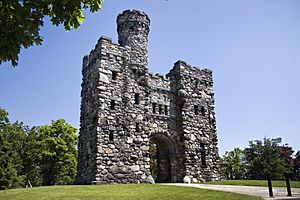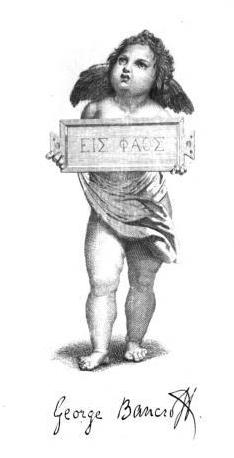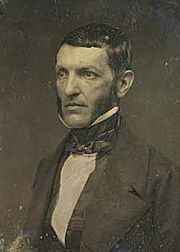George Bancroft facts for kids
Quick facts for kids
George Bancroft
|
|
|---|---|

Bancroft c. 1860
|
|
| United States Minister to Germany | |
| In office August 28, 1867 – June 30, 1874 |
|
| President | |
| Preceded by | Joseph A. Wright |
| Succeeded by | Bancroft Davis |
| United States Minister to the United Kingdom | |
| In office November 12, 1846 – August 31, 1849 |
|
| Monarch | Victoria |
| President | |
| Preceded by | Louis McLane |
| Succeeded by | Abbott Lawrence |
| 17th United States Secretary of the Navy | |
| In office March 11, 1845 – September 9, 1846 |
|
| President | James K. Polk |
| Preceded by | John Y. Mason |
| Succeeded by | John Y. Mason |
| Personal details | |
| Born | October 3, 1800 Worcester, Massachusetts, U.S. |
| Died | January 17, 1891 (aged 90) Washington, D.C., U.S. |
| Political party | Democratic |
| Spouses |
|
| Education | |
George Bancroft (born October 3, 1800 – died January 17, 1891) was an American historian and politician. He was a member of the Democratic Party. Bancroft was known for helping to improve education, especially for young people, in his home state of Massachusetts and around the world.
As the U.S. Secretary of the Navy, he started the famous United States Naval Academy in Annapolis. He also served as a top American diplomat in Europe, working in Britain and Germany. One of his most famous works is a long series of books called History of the United States, from the Discovery of the American Continent.
Contents
Early Life and Education
George Bancroft was born on October 3, 1800, in Worcester, Massachusetts. His family had lived in Massachusetts Bay since 1632. George's father, Aaron Bancroft, was a soldier during the American Revolution. He was also a leading Unitarian religious leader and wrote a popular book about George Washington.
His Schooling
Bancroft started his education at Phillips Exeter Academy. He then went to Harvard College when he was just thirteen years old. He graduated from Harvard in 1817.
After Harvard, Bancroft's father sent him to Germany to study. He attended the universities of Göttingen and Berlin. At Göttingen, he studied many subjects, including history, languages, and science. In 1820, he earned his doctorate degree from the University of Göttingen.
Bancroft finished his education with a trip around Europe. He met many famous writers, scientists, and artists of his time. These included Johann Wolfgang von Goethe, Wilhelm von Humboldt, Lord Byron, and Georg Wilhelm Friedrich Hegel.
Early Career and Politics
Bancroft came back to the United States in 1822. He briefly worked as a tutor of Greek at Harvard. However, he didn't like the old-fashioned way Harvard taught things. He also had different political views than many people in Boston.
Starting a School
In 1823, Bancroft published his first book, a small collection of poems. It didn't become famous. He then left Harvard and, with Joseph Cogswell, opened the Round Hill School in Northampton, Massachusetts.
While at Round Hill, Bancroft wrote often for magazines like the North American Review. He also translated a book about the politics of ancient Greece. In 1836, he gave a speech supporting the idea that all people should have the right to vote.
Massachusetts Politics
In 1830, Bancroft was chosen to be a member of the Massachusetts State Senate. He was elected by the Working Men's Party without even knowing it. However, he chose not to take the seat. The next year, he was offered another chance to join the state senate, but he said no again.
Historian and Writer
Bancroft was a very skilled scholar because of his studies in Germany. His most important work was a book series called History of the United States, from the Discovery of the American Continent. This series covered American history up to 1789. The first part came out in 1834, and he kept updating it over the years. It is still one of the most complete histories of early America.
His Main Ideas
Bancroft was a "Romantic" writer. This means he focused on ideas of national pride and freedom. He used four main ideas in his history books:
- Providence: He believed that God's plan, more than human actions, guided America's destiny.
- Progress: He thought that society could always get better through continuous improvements.
- Patria: This means "homeland." He believed America's growing influence would bring liberty to more people around the world.
- Pan-democracy: He saw the nation as the main character in history, not just individual heroes or villains.
Some historians say Bancroft's writings showed his belief in progress. He thought American history proved that God's plan for humanity was to develop religious and political freedom.
Political and Diplomatic Career
Collector of Boston Port
In 1837, Bancroft became more active in politics. President Martin Van Buren appointed him as the Collector of Customs for the Port of Boston. This job meant he was in charge of collecting taxes on goods coming into the port. He hired famous writers like Nathaniel Hawthorne to work in his office.
In 1844, Bancroft ran for governor of Massachusetts as a Democrat but lost. He supported adding Texas to the United States, saying it would expand "the area of freedom." He was also against slavery.
In 1845, President James K. Polk chose Bancroft to be his Secretary of the Navy. He served in this role until 1846. For one month, he was also the acting Secretary of War.
During his time as Secretary of the Navy, Bancroft created the United States Naval Academy in Annapolis. This school trains future naval officers and is a lasting part of his legacy. He also ordered naval actions that led to the United States taking control of California. As Secretary of War, he sent General Zachary Taylor into a disputed area between Texas and Mexico. This action helped start the Mexican War, which resulted in the U.S. gaining a lot of land in the Southwest.
Bancroft worked hard to set up the Naval Academy. Congress had not wanted to create a naval academy before. But Bancroft found a way by using the powers of the Secretary of the Navy. He ordered that "a place where midshipmen should wait for orders" be set up. He also arranged for instructors to teach them on shore. He used existing funds and got an old military post for the navy. When Congress met, they found the school was already running. They then approved it and gave money for its buildings.
Bancroft also brought in new, respected teachers and suggested a system for promoting officers based on their experience and achievements. He also helped get more money for the United States Naval Observatory.
Minister to the United Kingdom
Bancroft also studied the Oregon boundary dispute very carefully. In 1846, he was sent to London as a special diplomat to work with the British government on this issue. While there, he lived with famous writers like Macaulay. When Zachary Taylor became president, Bancroft's political job ended. In 1849, he moved to New York and focused on writing history books.
Return to Private Life
After leaving public office, Bancroft was at first unsure about Abraham Lincoln becoming president. However, he changed his mind after talking with Lincoln in 1861. He used their talks to argue for ending slavery. In 1864, President Lincoln wrote out a copy of the Gettysburg Address for Bancroft. Bancroft planned to sell this copy to raise money for Union Army soldiers.
In 1866, Congress chose Bancroft to give a special speech honoring Lincoln after his death.
Minister to Prussia and Germany
In 1867, President Andrew Johnson offered Bancroft the job of U.S. minister to Prussia. This allowed him to return to Germany. Bancroft stayed in Berlin for seven years. He was there during the Franco-Prussian War and when Germany became a united country.
President Ulysses S. Grant then appointed him minister to the German Empire in 1871. While in Berlin, Bancroft worked on agreements with Prussia and other German states about citizenship. These agreements became known as the Bancroft Treaties. These treaties were the first time that countries officially recognized the right of people to change their citizenship. This idea has since become part of international law.
San Juan Islands Arbitration
One of his most important achievements was helping to settle a border dispute. This was about the San Juan Islands (now in Washington State). The United States and Great Britain disagreed on which waterway was the correct border. Bancroft showed great skill and won the case for the U.S. The decision was made by a group of German judges chosen by the German Emperor. The final ruling came on October 21, 1872. British troops left San Juan Island on November 22, 1872, ending 26 years of tension.
Personal Life
Family Life
Bancroft's first wife was Sarah Dwight. They married in 1827 and had two sons. Sarah died in 1837. He later married Elizabeth Davis Bliss, who was a widow with two children. Together, they had a daughter.
In his later years, Bancroft lived in Washington, D.C.. He spent his summers at Rose Cliff in Newport, Rhode Island.
Organizations and Recognition
Bancroft was a member of the American Antiquarian Society starting in 1838. He was also a founding member and first president of the American Geographical Society. In 1863, he became a member of the American Academy of Arts and Sciences.
Death
George Bancroft died in 1891 in Washington, D.C.. He was the last living member of President Polk's cabinet. He is buried at Rural Cemetery in Worcester.
Works
Major Books
- Bancroft, George. History of the United States of America, from the Discovery of the American Continent. (Many editions from 1854–1878).
- Bancroft, George. History of the Battle of Lake Erie, and Miscellaneous Papers (1891).
- Bancroft, George. Martin Van Buren to the End of His Public Career. (1889).
- Bancroft, George. History of the Formation of the Constitution of the United States of America. (1882).
Namesakes and Monuments

Many things have been named after George Bancroft to honor him:
- The United States Navy named several ships USS Bancroft and the submarine USS George Bancroft (SSBN-643) after him.
- The main dormitory at the United States Naval Academy, Bancroft Hall, is named after him. It is the largest single dormitory in the world.
- Bancroft's name is on one of the marble pillars in the Library of Congress in Washington, D.C.
- In his hometown of Worcester, Massachusetts, and nearby areas, many places bear his name:
- Bancroft School, Worcester, MA
- Bancroft Hall at Phillips Exeter Academy, Exeter, New Hampshire
- Bancroft Tower, built in his honor in Salisbury Park, Worcester, MA
- Bancroft Commons, an apartment building in downtown Worcester, MA
- Bancroft Street in Gardner, MA, and Worcester, MA
- Bancroft Elementary Schools in Minneapolis, MN; Washington, D.C.; and Scranton, Pennsylvania
- There are also towns named Bancroft in Iowa and Maine.
Images for kids
See also
 In Spanish: George Bancroft para niños
In Spanish: George Bancroft para niños









